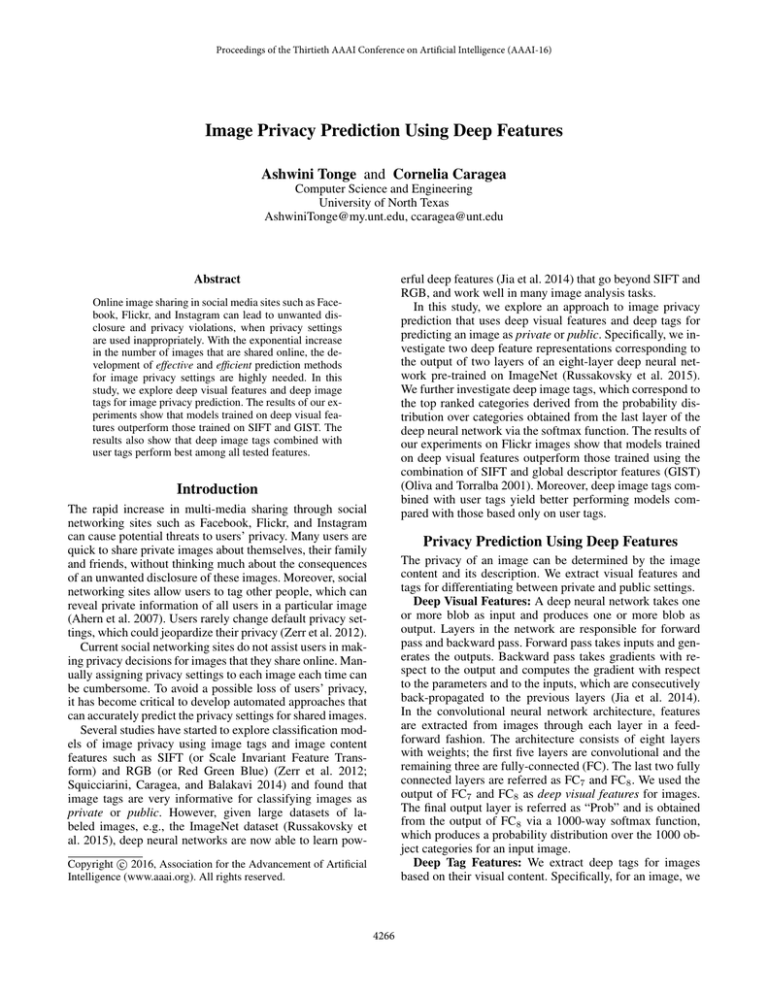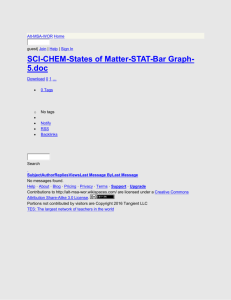
Proceedings of the Thirtieth AAAI Conference on Artificial Intelligence (AAAI-16)
Image Privacy Prediction Using Deep Features
Ashwini Tonge and Cornelia Caragea
Computer Science and Engineering
University of North Texas
AshwiniTonge@my.unt.edu, ccaragea@unt.edu
erful deep features (Jia et al. 2014) that go beyond SIFT and
RGB, and work well in many image analysis tasks.
In this study, we explore an approach to image privacy
prediction that uses deep visual features and deep tags for
predicting an image as private or public. Specifically, we investigate two deep feature representations corresponding to
the output of two layers of an eight-layer deep neural network pre-trained on ImageNet (Russakovsky et al. 2015).
We further investigate deep image tags, which correspond to
the top ranked categories derived from the probability distribution over categories obtained from the last layer of the
deep neural network via the softmax function. The results of
our experiments on Flickr images show that models trained
on deep visual features outperform those trained using the
combination of SIFT and global descriptor features (GIST)
(Oliva and Torralba 2001). Moreover, deep image tags combined with user tags yield better performing models compared with those based only on user tags.
Abstract
Online image sharing in social media sites such as Facebook, Flickr, and Instagram can lead to unwanted disclosure and privacy violations, when privacy settings
are used inappropriately. With the exponential increase
in the number of images that are shared online, the development of effective and efficient prediction methods
for image privacy settings are highly needed. In this
study, we explore deep visual features and deep image
tags for image privacy prediction. The results of our experiments show that models trained on deep visual features outperform those trained on SIFT and GIST. The
results also show that deep image tags combined with
user tags perform best among all tested features.
Introduction
The rapid increase in multi-media sharing through social
networking sites such as Facebook, Flickr, and Instagram
can cause potential threats to users’ privacy. Many users are
quick to share private images about themselves, their family
and friends, without thinking much about the consequences
of an unwanted disclosure of these images. Moreover, social
networking sites allow users to tag other people, which can
reveal private information of all users in a particular image
(Ahern et al. 2007). Users rarely change default privacy settings, which could jeopardize their privacy (Zerr et al. 2012).
Current social networking sites do not assist users in making privacy decisions for images that they share online. Manually assigning privacy settings to each image each time can
be cumbersome. To avoid a possible loss of users’ privacy,
it has become critical to develop automated approaches that
can accurately predict the privacy settings for shared images.
Several studies have started to explore classification models of image privacy using image tags and image content
features such as SIFT (or Scale Invariant Feature Transform) and RGB (or Red Green Blue) (Zerr et al. 2012;
Squicciarini, Caragea, and Balakavi 2014) and found that
image tags are very informative for classifying images as
private or public. However, given large datasets of labeled images, e.g., the ImageNet dataset (Russakovsky et
al. 2015), deep neural networks are now able to learn pow-
Privacy Prediction Using Deep Features
The privacy of an image can be determined by the image
content and its description. We extract visual features and
tags for differentiating between private and public settings.
Deep Visual Features: A deep neural network takes one
or more blob as input and produces one or more blob as
output. Layers in the network are responsible for forward
pass and backward pass. Forward pass takes inputs and generates the outputs. Backward pass takes gradients with respect to the output and computes the gradient with respect
to the parameters and to the inputs, which are consecutively
back-propagated to the previous layers (Jia et al. 2014).
In the convolutional neural network architecture, features
are extracted from images through each layer in a feedforward fashion. The architecture consists of eight layers
with weights; the first five layers are convolutional and the
remaining three are fully-connected (FC). The last two fully
connected layers are referred as FC7 and FC8 . We used the
output of FC7 and FC8 as deep visual features for images.
The final output layer is referred as “Prob” and is obtained
from the output of FC8 via a 1000-way softmax function,
which produces a probability distribution over the 1000 object categories for an input image.
Deep Tag Features: We extract deep tags for images
based on their visual content. Specifically, for an image, we
c 2016, Association for the Advancement of Artificial
Copyright Intelligence (www.aaai.org). All rights reserved.
4266
Features
FC7
FC8
SIFT + GIST
User Tags
Deep Tags
User+Deep Tags
Accuracy F1-Measure
Test (P iCalert783 )
81.23%
0.805
82.63%
0.823
72.67%
0.661
79.82%
0.782
80.59%
0.801
83.14%
0.827
Precision
Recall
0.804
0.822
0.672
0.786
0.799
0.826
0.812
0.826
0.727
0.798
0.806
0.831
million images annotated with 1000 object categories. We
resized images in both Train and Test to the CAFFE convolutional neural net compatible size of 227×227 and encoded
each image using the two deep feature representations corresponding to the output of the layers FC7 and FC8 .
Table 1 shows the performance of SVM using FC7 and
FC8 deep features, and SIFT+GIST features, on Test (first
three lines). We do not show the performance of SIFT and
GIST independently since they perform worse than their
combination. As can be seen from Table 1, both deep visual features FC7 and FC8 outperform SIFT + GIST, and
FC8 performs better than FC7 , in terms of all measures.
Deep Tags vs. User Tags. Next, we contrast the performance of SVM on user tags, deep tags, and the combination of user tags and deep tags. For deep tags, we consider
top k = 10 object categories as tags. We tried different
k values for the deep tags and achieved good results with
k = 10. Since tags generally appear only once per image,
we used Boolean features, i.e., 1 if a tag is present in an
image and 0 otherwise. Table 1 shows the results obtained
from the experiments for tag features on the Test set (last
three lines). As can be seen from the table, deep tags perform
only slightly better than user tags, but their combination outperforms both user tags and deep tags. A closed look at both
tag types revealed that user tags typically consist of general
terms, whereas deep tags consist of specific terms, which
could explain the improved performance of user + deep tags.
Table 1: Results for visual features.
predict top k object categories, corresponding to the highest
k probabilities from the probability distribution over categories, i.e., the “Prob” layer of the deep neural network. The
k predicted categories are used as tags to describe an image.
Experiments and Results
We evaluate our approach on Flickr images sampled from
the PiCalert dataset (Zerr et al. 2012). PiCalert consists of
Flickr images on various subjects, which are manually labeled as private or public by external viewers. Private images disclose sensitive information about a user, e.g., images with people, family pictures, etc., whereas public images generally depict scenery, objects, animals, etc., which
do not provide any personal information about a user. Previous works on this task used SIFT and user tags for privacy
prediction (Zerr et al. 2012; Squicciarini, Caragea, and Balakavi 2014). Our results indicate that deep visual features
and deep tags outperform these previous works.
We sampled 4, 700 images from PiCalert and used them
for our privacy prediction task. The public and private images are in the ratio of 3:1. We divided these images into two
subsets, Train and Test, using 6-fold stratified sampling.
Train consists of five folds randomly selected, whereas Test
consists of the remaining fold. The number of images in
Train and Test are 3, 917 and 783, respectively. In all experiments, we used the Support Vector Machine (SVM) classifier implemented in Weka and chose the hyper-parameters
(i.e., the C parameter and the kernel in SVM) using 5-fold
cross-validation on Train. We experimented with different
C values, and two kernels, linear and RBF.
Deep Visual Features vs. SIFT and GIST. We first compare the deep features, FC7 and FC8 with the combination
of SIFT and GIST features.
For SIFT, we constructed a vocabulary of 128 visual
words. Other vocabulary sizes, e.g., 500, 1000, did not yield
improvement in performance on Train using 5-fold crossvalidation. For GIST, we followed the steps: (1) convolve
the image with 32 Gabor filters at 4 scale and 8 orientations,
which produces 32 feature maps; (2) divide the feature map
into a 4 × 4 grid and average feature values of each cell; (3)
concatenate these 16 averaged values for 32 feature maps,
which result in a feature vector of 512 (16 × 32) length.
For the deep visual features, we used an already trained
deep convolutional neural network implemented in CAFFE
(Jia et al. 2014), which is an open-source framework for
deep neural networks. CAFFE implements an eight-layer
network pre-trained on a subset of the ImageNet dataset
(Russakovsky et al. 2015), which consists of more than one
Conclusion and Future work
We tackled the image privacy prediction task and showed experimentally that models trained on deep visual features and
the combination of user tags and deep tags yield remarkable
improvements in performance over models trained on features such as SIFT, GIST and user tags. In future, it would
be interesting to explore the combination of deep visual features with deep tags, using ensemble of classifiers.
Acknowledgments We would like to thank Adrian Silvescu and Raymond J. Mooney for helpful discussions. This
research is supported in part by the NSF award #1421970.
References
Ahern, S.; Eckles, D.; Good, N. S.; King, S.; Naaman, M.; and
Nair, R. 2007. Over-exposed?: Privacy patterns and considerations
in online and mobile photo sharing. In SIGCHI’07.
Jia, Y.; Shelhamer, E.; Donahue, J.; Karayev, S.; Long, J.; Girshick,
R.; Guadarrama, S.; and Darrell, T. 2014. Caffe: Convolutional architecture for fast feature embedding. In Intl. Conf. on Multimedia.
Oliva, A., and Torralba, A. 2001. Modeling the shape of the scene:
A holistic representation of the spatial envelope. Int. J. Comput.
Vision 42(3):145–175.
Russakovsky, O.; Deng, J.; Su, H.; Krause, J.; Satheesh, S.; Ma, S.;
Huang, Z.; Karpathy, A.; Khosla, A.; Bernstein, M.; Berg, A. C.;
and Fei-Fei, L. 2015. ImageNet Large Scale Visual Recognition
Challenge. International Journal of Computer Vision (IJCV) 1–42.
Squicciarini, A. C.; Caragea, C.; and Balakavi, R. 2014. Analyzing
images’ privacy for the modern web. In HT 2014.
Zerr, S.; Siersdorfer, S.; Hare, J.; and Demidova, E. 2012. Privacyaware image classification and search. In SIGIR’12.
4267




